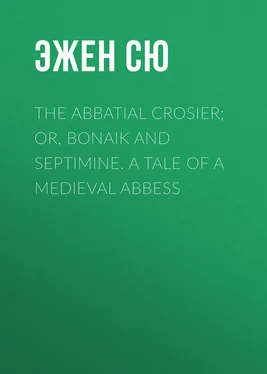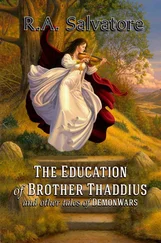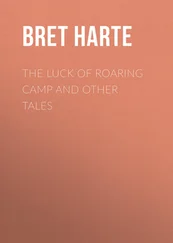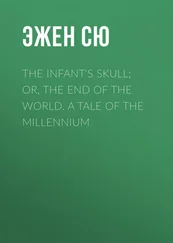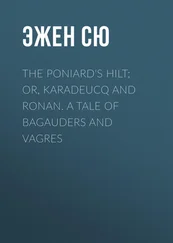Эжен Сю - The Abbatial Crosier; or, Bonaik and Septimine. A Tale of a Medieval Abbess
Здесь есть возможность читать онлайн «Эжен Сю - The Abbatial Crosier; or, Bonaik and Septimine. A Tale of a Medieval Abbess» — ознакомительный отрывок электронной книги совершенно бесплатно, а после прочтения отрывка купить полную версию. В некоторых случаях можно слушать аудио, скачать через торрент в формате fb2 и присутствует краткое содержание. Жанр: literature_19, foreign_antique, foreign_prose, на английском языке. Описание произведения, (предисловие) а так же отзывы посетителей доступны на портале библиотеки ЛибКат.
- Название:The Abbatial Crosier; or, Bonaik and Septimine. A Tale of a Medieval Abbess
- Автор:
- Жанр:
- Год:неизвестен
- ISBN:нет данных
- Рейтинг книги:4 / 5. Голосов: 1
-
Избранное:Добавить в избранное
- Отзывы:
-
Ваша оценка:
- 80
- 1
- 2
- 3
- 4
- 5
The Abbatial Crosier; or, Bonaik and Septimine. A Tale of a Medieval Abbess: краткое содержание, описание и аннотация
Предлагаем к чтению аннотацию, описание, краткое содержание или предисловие (зависит от того, что написал сам автор книги «The Abbatial Crosier; or, Bonaik and Septimine. A Tale of a Medieval Abbess»). Если вы не нашли необходимую информацию о книге — напишите в комментариях, мы постараемся отыскать её.
The Abbatial Crosier; or, Bonaik and Septimine. A Tale of a Medieval Abbess — читать онлайн ознакомительный отрывок
Ниже представлен текст книги, разбитый по страницам. Система сохранения места последней прочитанной страницы, позволяет с удобством читать онлайн бесплатно книгу «The Abbatial Crosier; or, Bonaik and Septimine. A Tale of a Medieval Abbess», без необходимости каждый раз заново искать на чём Вы остановились. Поставьте закладку, и сможете в любой момент перейти на страницу, на которой закончили чтение.
Интервал:
Закладка:
Eugène Sue
The Abbatial Crosier; or, Bonaik and Septimine. A Tale of a Medieval Abbess
TRANSLATOR'S PREFACE
The turbulent epoch that rocked the cradle of the Carlovingian dynasty, the dynasty from which issued the colossal historic figure of Charlemagne, is the epoch of this touching story – the eighth of the series of Eugene Sue's historic novels known collectively under the title " The Mysteries of the People; or, History of a Proletarian Family Across the Ages ." From the seething caldron of the valleys of the western Rhine, inundated by the Arabs from the south, the Frisians from the north, the Saxons from the west, and in which the chants of Moslems, of Christians and of barbarians mixed into the one common cry of desolating war, the feudal social system, previously introduced by Clovis, and now threatened to be engulfed, emerged from the chaos as a social institution. Many a characteristic of feudalism would be missed if this, a crucial period of its existence, is not properly apprehended. As in all the others of this series of Eugene Sue's stories, the information is imparted without the reader's knowledge. What may be termed the plot seizes and keeps the interest from start to finish, steadily enriching the mind with knowledge historically inestimable, besides connecting with the era described in the previous story — The Branding Needle; or, The Monastery of Charolles – and preparing the ground for the thrilling events that are the subject of the succeeding narrative — The Carlovingian Coins; or, The Daughters of Charlemagne .
DANIEL DE LEON.New York, 1904.
PROLOGUE
CHAPTER I.
NARBONNE
Cruel intestine wars between the descendants of the Frankish conquerors were devastating Gaul when the Arab invasion took place in 719. The invaders poured down from the Pyrenees and drove back or subjugated the Visigoths. The exchange of masters was almost a gain to the inhabitants of the region. The conquerors from the south were more civilized than those from the north. Many of the Gauls, – either freemen, or colonists or slaves – took so strongly to the southern invader that they even embraced his religion, the religion of Mahomet, allured thereto by the promises of a paradise peopled with houris. "The virtuous believer," declared the Koran, "will be taken to the delicious home of Eden, enchanted gardens, through which well-shaded rivers flow. There, ornamented with bracelets of gold, clad in green clothes of woven silk and resplendent with glory, the faithful will recline upon nuptial beds, the happy prize in the dwelling of delights." Preferring, accordingly, the white houris promised by the Koran to the winged seraphs of the Christian paradise, many Gauls embraced Mohamedanism with ardor. Mosques rose in Languedoc beside Christian churches. More tolerant than the bishops, the Arabs allowed the Christians to follow their own religion. Moreover, Mohamedanism, founded by Mahomet during the previous century, 608, acknowledged the divinity of the Scriptures and recognized Moses and the Jewish prophets as beings chosen by God, only it did not recognize the godship of Jesus. "Oh, ye, who have received the Scriptures, keep within the bounds of the faith. Speak only the truth about God. Jesus is the son of Mary, and he was sent by the All-High, but is not his son. Say not that God is a trinity. God is one. Jesus will not blush at being the servant of God. The angels that surround the throne of God obey God!" – thus spoke the Koran.
The town of Narbonne, capital of Languedoc under the dominion of the Arabs, had in 737 quite an Oriental aspect, due as much to the clearness of the sky as to the dress and customs of a large number of its inhabitants. The laurel shrubs, the green oaks and palm trees recalled the vegetation of Africa. Saracen women were seen going to or coming from the fountains with earthen vessels nicely balanced on their heads, and draped in their white clothes like the women of the time of Abraham, or of the young master of Nazareth. Camels with their long necks and loaded with merchandise left the town for Nimes, Beziers, Toulouse or Marseilles. The caravans passed on these journeys, along the fields, a great variety of settlements – mud hovels thatched with straw and inhabited by Gallic peasants, who were successively the slaves of the Visigoths and of the Musselmen; tents of a Barbary tribe, Arabian mountaineers who had descended to the plains from the peak of Mt. Atlas, and who preserved in Gaul the nomad habits of their old home, warriors, ever ready to mount their tireless and swift horses in answer to the first call of battle from the emir of the province; finally, and at long distances apart, on the crests of the mountains, high towers where, during war, the Saracens lighted fires for the purpose of signaling the approach of the enemy to one another.
In the almost Musselman town of Narbonne, the same as in all the other towns of Gaul under the sway of the Franks and the bishops, there were, sad to say, public market-places where slaves were set up for sale. But that which imparted a peculiar character to the market of Narbonne was the diversity of the races of the captives that were offered to purchasers. There were seen negroes and negresses in large numbers, as well as Ethiopians of ebony blackness; copper-colored mestizos; handsome young Greek girls and boys brought from Athens, Crete or Samos and taken prisoner on some of the frequent maritime raids made by the Arabs. A skilful politician, Mahomet, their prophet, had incited in his sectarians a passion for maritime expeditions. "The believer who dies on land feels a pain that is hardly comparable with the bite of an ant," says the Koran, "but the believer who dies at sea, feels on the contrary the delicious sensation of a man, who, a prey to burning thirst, is offered iced water mixed with citron and honey." Around the slave market stood numerous Arabian shops filled with merchandise mainly manufactured at Cordova or Granada, centers, at the time, of Saracen art and civilization: brilliant arms inlaid in arabesques with gold and silver, coffers of chiseled ivory, crystal cups, rich silk fabrics, embroidered hose, precious collars and bracelets. Around the shops pressed a crowd of as various races as costumes: aboriginal Gauls in their wide hose, an article that gave this section of Gaul the name of "Bracciata" with the Romans; descendants of the Visigoths who remained faithful to their old Germanic dress, the furred coat, despite the warmth of the climate; Arabians with turbans of all colors. From time to time, the cry of the Musselman priests, calling the believers to prayer from the height of the minarets, mixed with the chimes of basilicas that summoned the Christians to their devotions.
"Christian dogs!" said the Arabs or Musselman Gauls. "Accursed heathens, damned degenerates!" answered the Christians; whereupon both proceeded to exercise their own cult in peace. More tolerant than the bishops of Rome, Mahomet said in the Koran: "Do not do violence upon men for reason of their religion."
CHAPTER II.
ABD-EL-KADER AND ROSEN-AER
Abd-el-Kader, one of the bravest chiefs of the warriors of Abd-el-Rhaman during the life of this emir, who was killed five years before on the field of Poitiers where he delivered a great battle to Charles Martel (the Hammer) – Abd-el-Kader, after ravaging and pillaging the country and the churches of Tours and of Blois, occupied one of the handsomest dwellings in Narbonne. He had the house arranged in Oriental fashion – the outside windows were closed up, and laurels were planted in the inner courtyard, from the center of which a fountain jetted its steady stream. His harem occupied one of the wings of the house. In one of the chambers of this harem, covered with rich carpets of gay colors, furnished with silk divans, and lighted by a window with gilded bars, sat a woman of rare beauty, although about forty years of age. It was easy to recognize by the whiteness of her skin, the blondness of her hair and the blue of her eyes that she was not of Arabian stock. Her pale and sad face revealed a settled and profound sorrow. The curtain that covered the door of the chamber was pushed aside and Abd-el-Kader entered. The swarthy-complexioned warrior was about fifty years of age; his beard and moustache were grizzled; his face, calm and grave, expressed dignity and mildness. He stepped slowly towards the woman and said to her: "Rosen-Aër, we meet to-day for the last time, perhaps."
Читать дальшеИнтервал:
Закладка:
Похожие книги на «The Abbatial Crosier; or, Bonaik and Septimine. A Tale of a Medieval Abbess»
Представляем Вашему вниманию похожие книги на «The Abbatial Crosier; or, Bonaik and Septimine. A Tale of a Medieval Abbess» списком для выбора. Мы отобрали схожую по названию и смыслу литературу в надежде предоставить читателям больше вариантов отыскать новые, интересные, ещё непрочитанные произведения.
Обсуждение, отзывы о книге «The Abbatial Crosier; or, Bonaik and Septimine. A Tale of a Medieval Abbess» и просто собственные мнения читателей. Оставьте ваши комментарии, напишите, что Вы думаете о произведении, его смысле или главных героях. Укажите что конкретно понравилось, а что нет, и почему Вы так считаете.
